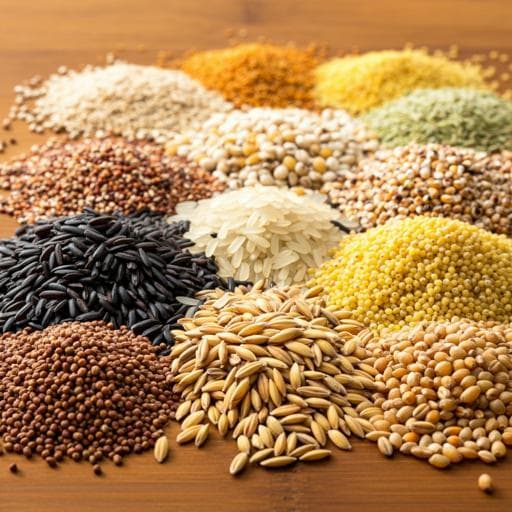
Agriculture
Crop switching for water sustainability in India's food bowl yields co-benefits for food security and farmers' profits
R. Chakraborti, K. F. Davis, et al.
Discover how a revolutionary crop switching optimization model could combat groundwater depletion in the Indo-Gangetic Plain, as explored by Ruparati Chakraborti and colleagues. This innovative research reveals the potential to reduce water consumption by 32%, boost calorie production by 39%, and enhance farmers' profits by 140%.
~3 min • Beginner • English
Introduction
Feeding a projected global population of 10 billion by 2050 will require approximately 70% more agricultural production, likely increasing water and energy demand and exacerbating environmental stress. India, producing 11% of global cereals and employing 59% of its workforce in agriculture, relies heavily on the Indo-Gangetic Plain (IGP) for cereal supply. The IGP’s dominant rice–wheat system, supported by extensive irrigation (about 40% from groundwater) and electricity subsidies, has driven unsustainable groundwater abstraction and rising energy use. Recent observations show declining monsoon and annual rainfall in parts of the IGP and significant groundwater depletion, with increased irrigation demand and limited gains in calorie productivity per unit water. Given these challenges, solutions must jointly address water savings, food security, and farmers’ profits. While prior work suggests that less water-intensive cereals (millets, sorghum) could yield water and food benefits, feasibility requires incorporating economic outcomes for farmers and local context. This study develops a district-level, multi-objective crop-switching optimization for IGP cereals to simultaneously minimize irrigation water consumption and maximize calorie production and farmers’ profits, holding total cereal area constant. It addresses three research questions: (1) What are the trends in cereal production and water consumption in the IGP? (2) What cereal substitutions maximize calories and profits while minimizing water? (3) Which combination of irrigation practice (flood vs drip) and crop switching maximizes groundwater net recharge?
Literature Review
Existing studies at global and national scales indicate potential to reduce water use and increase food production through optimized crop distribution and crop switching. India-specific assessments have shown that replacing rice and wheat with millets and sorghum can save water and energy and improve environmental sustainability, but most use single-objective frameworks and often omit farmers’ profitability. Research on improving irrigation efficiency (e.g., shifting from flood to drip) suggests potential reductions in groundwater extraction but may also lower recharge, complicating net benefits. The IGP lacks integrated, policy-relevant analyses that consider multiple objectives—food, water, energy, and farmer economics—at local-to-regional scales. This study advances prior work by employing a multi-objective, district-level optimization that accounts for calorie production, irrigation water use, and farmers’ profits, and by comparing crop switching with irrigation technology changes.
Methodology
Study region and data: Three IGP states—Uttar Pradesh, Bihar, and West Bengal—covering 124 districts. Data (1998–2015) include: IMD gridded rainfall and temperature; soil texture (HWSD); district-level crop production and area (irrigated vs rainfed); groundwater well observations; specific yield; minimum support prices (MSP) and cost of cultivation; calorie content; irrigation water consumption for flood and drip; and sectoral water uses from WaterGAP v2.2d.
Trends and baseline quantification: • Mapped trends in annual and monsoon rainfall (Mann–Kendall, 0.05 significance). • Computed sectoral water consumption; irrigation demand for cereals vs other sectors. • Derived district cereal calorie production and calorie per unit water consumption. • Assessed groundwater level trends from well data and simulated recharge/abstraction.
Crop yield modeling and yield gap: • Simulated attainable yields with FAO AquaCrop-OS at grid scale using weather (Tmax, Tmin, rainfall, reference ET via VIC Penman–Monteith), crop parameters (FAO), soils (HWSD), and management. • Partitioned observed district yields into rainfed and irrigated components using national irrigated-to-rainfed yield ratios derived from Cost of Cultivation survey data. • Defined yield gap as simulated attainable minus observed yield. • For optimization scenarios, considered three yield datasets: (1) OOY: partitioned observed yields; (2) OSY: AquaCrop-simulated yields; (3) OMYG: yields set to the 90th percentile of district-level observed yields within each agroecological zone (upper, middle, lower Gangetic plains).
Multi-objective crop-switching optimization: • Decision variables: cereal crop area fractions by district (rainfed and irrigated shares fixed to current levels). • Crops considered: Kharif—rice, maize, millet (pearl millet), sorghum; Rabi—wheat, sorghum, barley. Total cereal area per district held constant. • Objectives: maximize farmers’ profits (using MSP and cost of cultivation), maximize calorie production, minimize irrigation water consumption. • Objective functions computed from crop areas, rainfed/irrigated yields, MSP, cultivation costs, calorie values, and water consumption. • Multi-objective solution via max–min (goal programming) approach, normalizing each objective between its district-specific minimum and maximum (if all area assigned to the crop that minimizes/maximizes that objective). • Solver: Probabilistic Global Search Lausanne (PGSL) stochastic global optimizer in MATLAB. • Post-optimality analysis: Pareto trade-offs; sensitivity to ±10% changes in yields, costs, MSP, and irrigation water use. • Constraints: sum of area fractions equals 1, rainfed/irrigated splits fixed, district total cereal area fixed; no explicit limits on degree of crop substitution in the base optimization (tested alternative constraints in sensitivity).
Groundwater modeling and energy use: • Abstraction computed from irrigation water consumption and groundwater fraction of irrigated area plus domestic/industrial/livestock drafts (from WaterGAP). • Recharge via GEC-97 (CWC) methodology: rainfall infiltration (RIF=22% for alluvium) and irrigation return flows (RFFs; adjusted for paddy hardpan). Net recharge equals recharge minus abstraction; linked to groundwater level change using specific yield. • Energy for pumping: Power = (Q·ρ·g·head)/η; annual energy assuming 8 hours/day pump use; head equals groundwater depth; Q from abstraction.
Scenario comparisons for irrigation method: • Case 1: Existing crop pattern with drip irrigation (vs flood). • Case 2: Optimized crop pattern with flood irrigation. • Case 3: Optimized crop pattern with drip irrigation. Outcomes compared for net recharge and energy savings relative to base (existing crops with flood irrigation).
Key Findings
Trends and baseline: • Rainfall declined significantly in Uttar Pradesh and West Bengal; no prominent trend in Bihar. • Irrigation water consumption for cereals increased significantly, particularly where rainfall declined; cereals account for ~50% of total regional water consumption. • Calorie production per unit water showed limited or no significant improvement on average, highlighting unsustainable current practices. • Groundwater abstraction increased by 3.9 km³ per year across the three states; widespread groundwater level declines observed and simulated; spatial consistency between increased cereal irrigation and groundwater depletion patterns.
Optimization outcomes—general (OOY and OSY): • With observed yields (OOY), the model replaces substantial rice area in Kharif with maize, millet, and sorghum; and replaces wheat with sorghum and barley in Rabi. Water consumption decreases broadly; profits rise in most districts; calories do not improve in a subset of districts due to low observed yields of alternative cereals. • With simulated yields (OSY), replacement shifts more strongly toward millet (Kharif) and sorghum (Rabi), delivering water savings and increases in both profits and calories in all districts, indicating the importance of closing yield gaps.
Optimization with yield-gap closure (OMYG; 90th percentile yields by agroecological zone): • Kharif: Rice area reduced by 36% (rainfed) and 85% (irrigated); increases in millet and maize (rainfed) and sorghum (irrigated). • Rabi: Wheat replaced predominantly by sorghum in irrigated areas (80% increase in sorghum area). • Regional outcomes relative to existing practices (with comparable 90th percentile yields applied to current patterns): – Water savings: 55% (Kharif) and 9% (Rabi). – Profit increases: 139% (Kharif) and 152% (Rabi). – Calorie increases: 19% (Kharif) and 38% (Rabi).
Aggregate potential (headline from abstract): Switching from rice to millets and sorghum (Kharif) and from wheat to sorghum (Rabi) could reduce water consumption by 32%, increase calorie production by 39%, and raise farmers’ profits by 140%.
Irrigation method vs crop switching—net recharge and energy: • Net recharge improvements relative to base: – Drip only (Case 1): +34%. – Crop switching with flood (Case 2): +41%. – Crop switching plus drip (Case 3): +78%. • Energy savings relative to base: – Drip only: 14%. – Crop switching only: 21%. – Combined: 36%.
Nutritional co-benefits: • Replacing rice–wheat with sorghum and millets increases production of protein by 46%, iron by 353%, and zinc by 82%.
Sensitivity and robustness: • Pareto analyses confirm trade-offs, with the max–min solution balancing objectives; sensitivity tests (±10% on inputs) show stable decisions, except minor variations for Rabi sorghum/barley in rainfed areas.
Additional quantitative context: • Gangetic basin lost 227 ± 25 km³ of groundwater (2002–2016, prior studies).
Discussion
The multi-objective, district-level optimization demonstrates that targeted crop switching from water-intensive rice–wheat to less water-intensive cereals (sorghum and millets, and barley in some Rabi contexts) can concurrently address water sustainability, food security, and farmer livelihoods. By including farmers’ profits via MSP and cost of cultivation in the objectives, the solutions are more feasible and policy-relevant than single-objective approaches. Yield-gap closure—approximated here by using the 90th percentile of observed yields within agroecological zones—emerges as a key enabler, converting previously mixed calorie outcomes into consistent co-benefits across districts. Comparisons with irrigation technology change show that crop switching delivers greater improvements in net groundwater recharge and comparable or greater energy savings than drip irrigation alone; combining both provides the largest benefits. Nutritional outcomes also improve significantly under switching to nutrient-dense cereals, aligning with public health goals. These results directly address the research questions by quantifying trends (increasing irrigation water and groundwater depletion), identifying optimal cereal substitutions under multiple objectives, and demonstrating that crop switching (with or without drip) outperforms irrigation efficiency improvements alone in enhancing net recharge and reducing energy use, while improving calories and profits. The findings support policy shifts toward diversified, climate-resilient cereal systems and procurement frameworks that incentivize alternative cereals.
Conclusion
This study contributes a policy-relevant, multi-objective optimization framework for district-level crop switching in the IGP, integrating food (calories), water (irrigation demand and groundwater dynamics), and farmer economics (profits). It identifies widespread replacement of Kharif rice with sorghum and millets and Rabi wheat with sorghum as a robust strategy. Under yield-gap closure to the 90th percentile, the optimized patterns reduce irrigation water use (55% Kharif, 9% Rabi), increase profits (139% and 152%), and increase calories (19% and 38%), while improving net groundwater recharge more than drip irrigation alone; combined strategies maximize benefits. Nutritional outputs (protein, iron, zinc) also rise substantially. Future research directions include: • Incorporating detailed, granular crop suitability, management, and input-use data; • Linking yield-gap closure to realistic cost changes and extension/investment needs; • Considering cross-district reallocations (regional optimization) and constraints on substitution magnitudes; • Integrating consumer demand shifts, market access, post-harvest processing, and PDS procurement of alternative cereals; • Embedding RCP–SSP climate and socio-economic scenarios with population-driven demand projections; • Refining hydrological representation (e.g., explicit canal/tank recharge, coupled surface–groundwater and paddy hydrology).
Limitations
• Profit estimates use MSP applied to total cereal production (fraction under MSP unknown), and do not reflect open market price variability. • Yield-gap closure scenarios assume yield improvements without adjusting cultivation costs due to lack of data; real-world investments could alter cost and profitability. • No explicit base constraint on the extent of rice/wheat substitution (though tested scenarios with capped reductions show diminished benefits). • District-level total cereal area is held constant; analyses do not consider cross-district reallocation or total production constraints at larger scales. • AquaCrop simulations lack plot-level irrigation and fertilizer inputs; yield simulations may overestimate under idealized assumptions. • Groundwater modeling via GEC-97 is a simplified representation; recharge from canals, tanks, ponds, and conservation structures is not included due to data limitations; paddy hardpan effects are approximated. • Spatial resolution limited to districts; finer-scale agroecological heterogeneity and local suitability not fully captured. • Adoption barriers (farmer preferences, market access, processing, PDS logistics, consumer demand) are not modeled and may affect feasibility and timelines.
Related Publications
Explore these studies to deepen your understanding of the subject.







